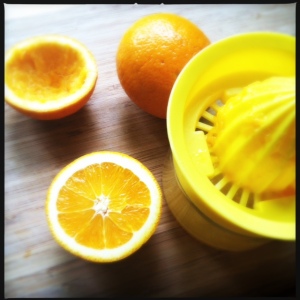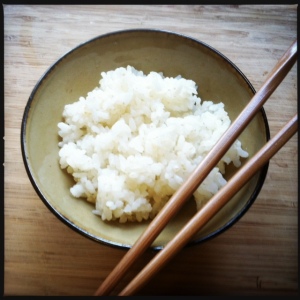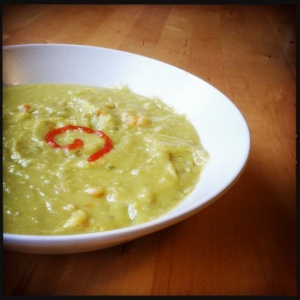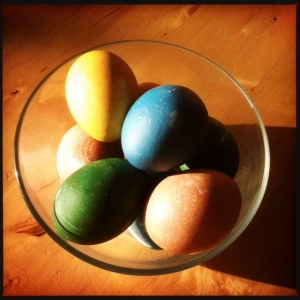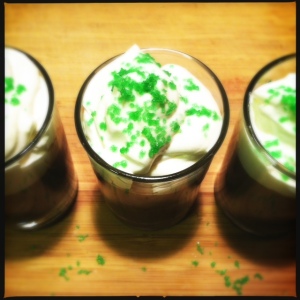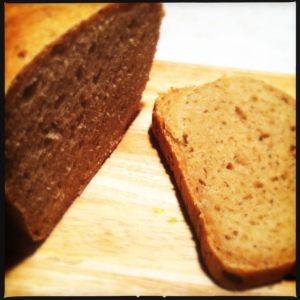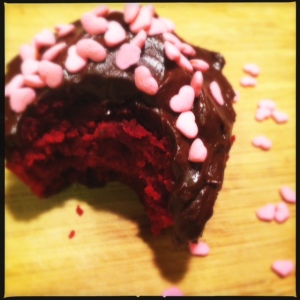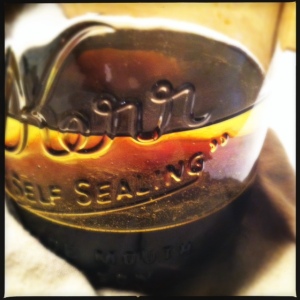Ever since I found out that traces of a cancer-causing form of arsenic have been found in several brands of both apple and grape juice, I’ve been on a mission to find alternatives for my little guy.
We first got into the juice habit when Bug was about 18 months old in hopes of weaning him off “Mom Milk.” He wasn’t really into water, or cow milk. But apple juice, well, he might make an exception for apple juice.
So, sometimes when he was clamoring for Mom Milk a bit too loudly, I would counter with apple juice, which he mostly accepted. (Although it didn’t seem to dim his interest in Mom Milk at all – a year later I am still trying to wean. Yeah, I know, hippie mama alert, though I can honestly say I did not plan to breastfeed for quite so long.)
So we fell into the juice habit, and soon he was asking for it daily.
At the time, I was still trying to do my grocery shopping with little dude in tow, which was total chaos. So I wasn’t really able to look too closely at the labels and see what the difference was amongst all the options out there. Mainly I was just trying to get out of the store as quickly as possible before a meltdown opportunity arose.
But I figured if I stuck with 100% juice, with no added sugar, he would at least be getting some sort of nutritional value (in my mind, it was like eating fruit in liquid form). And I figured the organic version was basically insurance against anything funky in there.
Most of the time I bought apple juice because it was usually the easiest of all the juices out there to find a version that was 100% juice, with no added sugar, and organic.
Until I read about the whole arsenic hullabaloo. Apparently several brands of apple and grape juice, including organic versions, had traces of a cancer-causing form of arsenic (and lead, sheesh) at levels higher than the federal limit for drinking or bottled water (although there is not currently any federal limit for these substances in juice).
Which made me realize that I actually knew very little about juice, about where it comes from, how it is produced, what all the different types are, how much sugar is in them, etc. I also had no idea how much, if any, was ok to give my little guy.
So I set about researching all the above, which led me down the rabbit hole, from which I did not surface for several weeks.
I’m not quite sure that I have it all figured out, but at least I have a sort of rationale for it all.
So it turns out that pediatricians recommend kids between 1 and 6 years old drink no more than 4 to 6 ounces of juice daily. That’s about 1/2 to 2/3 of a cup, which is actually less than many of the juice boxes on the market – many contain 8 ounces, or about 1 cup.
Then there are all the different kinds of juices out there.
At my local Fred Meyer, there is nearly a whole aisle dedicated to shelf stable juice, a refrigerated case for perishable juice, a freezer section for frozen concentrate, plus another small aisle for organic or “healthier” shelf stable juice.
Within each of those sections is a crazy amount of variety, everything from 100% juice to “flavored water beverage,” which is essentially sugar water with fruit flavor (ahem, Capri Sun Roarin’ Waters).
So which kind of juice is best?
Whenever I start to get overwhelmed at the grocery store, I turn to Marion Nestlé for insight. Her book, What To Eat, gives some basic guidelines on how to navigate the incredibly complex landscape that is our food system. She has this to say about juice:
“On the basis of taste and, to a lesser extent, nutritional value, the priority order for juices is 1) fresh-squeezed, 2) squeezed and pasteurized, and 3) reconstituted from concentrate…”
Of course, once I figured all that out, I came across this article that basically says even 100% juice is essentially just as sugary and implicated in childhood obesity as soda. With some vitamins and minerals mixed in. Apparently it’s not quite the same as drinking liquid fruit. The line that really caught my attention was that 1 cup of juice has the same amount of sugar as 6 apples, without all that good fiber.
Who knew something so simple could be so complicated?
After all the research I was ready to give up on juice and just stick with water. Which is certainly the easiest and most cost effective option out there.
But, realistically, when we go on play dates and all the other kids are running around drinking all kinds of alluring concoctions from all sorts of fun packages, it sure is a tough sell to bust out the homely mason jar full of totally boring water.
As it is, Bug is always interested in what everyone else is consuming, and is not above sampling someone else’s sippy cup or juice box.
So, it would be nice to give him something that was enticing enough to keep him from grabbing other kid’s drinks, but not too crazy sugary, or ummm, arsenic-laden.
So what is a mama to do? I think Nestle sums it up nicely:
“…choose the freshest 100 percent juices you can afford, don’t drink too much of them (12 ounces a day is more than enough for an adult), and leave everything else – juice drinks, sports drinks, buzz drinks – where you found them. Do not let your children drink more than 6 ounces of juice a day, and do not let them drink “juice” drinks at all except, perhaps, as an occasional treat – just like any other candy or dessert.”
So very sensible. I figured if we stuck with her recommendations, we would be doing ok.
So I scoured the grocery store looking for suitable alternatives and found not a whole lot, actually. There were plenty of 100% apple juice options out there, which I don’t intend to rule out completely, though I do plan to cut down on it until federal limits are in place for arsenic levels in juice. There were also a lot of 100% juices (cherry, cranberry) that included apple or grape juice concentrate, I’m assuming as a sweetener. I did turn up a shelf stable organic 100% pineapple juice, surprisingly not from concentrate, and a shelf stable 100% prune juice, also not from concentrate, both of which would be great to have on hand.
But I figured homemade would be fresher and tastier than anything at the store.
At first I considered buying a juicer, and making him juice fresh everyday. But yeah, waaay too much effort. We used to have one and it got very little action, mainly because it was such a pain to use. It had a million pieces and somehow always managed to leak juice all over the counter. I really couldn’t see hauling that thing out everyday, washing and prepping a bunch of fruit or veg, then cleaning up the mess. Plus, it takes a whole lotta fruit and veg to make just a little bit of juice. And I sure don’t need another contraption to care for.
But I liked the idea of juicing, and thought maybe juicing oranges would be doable, in small batches. So I bought a low tech juicer for 2.99 at Target and a bag of Valencias, and I was good to go. It was super easy to make, super easy to clean up and super tasty too, way better than anything at the grocery store. A totally viable option most of the time, except for those mornings when we are rushing to get out of the house.
Then I came across this post (which has just been switched to private, looks like) and my mind was blown. Homemade orange juice concentrate! What! I could squeeze the juice fresh, freeze it, then make a batch as needed, instead of juicing on demand every time. Plus I liked the idea of blending the pulp right in, so it really is more like drinking an orange.
I was all set to give it a go, but then I came across this post for super cute ice cubes. So adorable, right?
And I thought, what if these two ideas hooked up and had a baby?
Then you would totally get fresh squeezed orange juice concentrate ice cubes!
I liked this idea even better. With the ice cubes I could make tiny batches whenever for my little munchkin, since neither hubbie nor I drink much juice anyway.
In my mind, I imagined adding some water to the homely mason jar, then throwing in a few orange juice ice cubes, instantly transforming it into toddler bait.
Which it does, more or less, although Bug usually ends up pouring out the water so he can focus on working over the ice, which keeps him quiet for a good 15 minutes or so.
Not quite what I had in mind, but I’ll take it.
Freshly squeezed orange juice ice cubes
Recipe notes: I tried a batch with the whole fruit blended right into the juice, like in the post for orange juice concentrate, which made a sort of thick purée. But honestly, I was not that into them. I liked the wholesomeness of them, but the taste was kinda meh, especially when mixed with water. Maybe because the oranges I used were better for juicing than eating in the first place. So anyway, now I just juice the oranges, plain and simple. I freeze the juice in an OXO ice cube tray, which makes 14 ice cubes. About 5 or 6 large oranges make enough juice to fill the tray, and 6 ice cubes is about 4 ounces (1/2 cup). Originally I intended to add the juice cubes to water, to dilute the juice a bit and get a little more bang for the buck (which would have made them more like orange juice concentrate), but now I mostly just give Bug a juice cube and let him go to town. If we are headed out for a play date, I just throw a handful of juice cubes in a mason jar and by the time we are ready for snack time, they are slushy and melty and good to go. I included rough measurements for those trying to stick closely to the 4-6 ounce rule. Do I stick to the rule? Honestly, it depends on the day. Some days I am just trying to survive, and if that means a little more juice for Bug, well, then let’s get the party started.
Ingredients
A big old bag of oranges
Directions
Juice those oranges. You better work (this is my soundtrack for juicing). Pour juice into ice cube tray and freeze. To serve, add 6 juice cubes (1/2 cup or 4 ounces) to ¼ to 1/2 cup of water (2 to 4 ounces). Or just nix the water and down those cubes neat.
